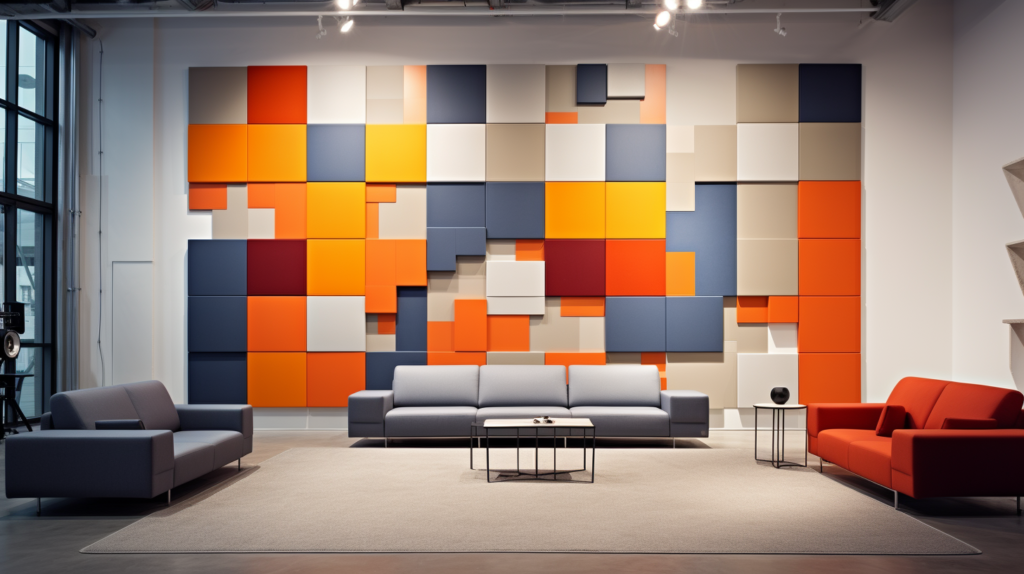Are you torn between the need for better acoustics and the desire for a visually appealing space?
In the modern quest for perfect sound quality, acoustic panels have become a necessity for creating optimal listening environments.
But what happens when these functional pieces have to coexist with your interior design aspirations?
You may think the only option is to hide them, but we have a game-changing alternative: decorative polyester acoustic panels.
In this blog post, we’ll explore why some people feel compelled to hide their acoustic panels, the implications of doing so, and innovative ways to incorporate them into your decor without compromising on style or functionality.
Say goodbye to the dilemma of choosing between aesthetics and acoustics.
So, let’s dive in and unlock the secrets to a harmonious living space!
Why Hide Your Acoustic Panels?

Now that we’ve established that acoustic panels are needed to help create spaces that are optimal for you, there can be several reasons why people might want to hide acoustic panels:
1. They Are Aesthetically Unpleasing Acoustic Panels
One of the primary reasons people want to hide acoustic panels is due to aesthetics.
Some individuals may find the appearance of acoustic panels to be visually unappealing or not aligned with their desired interior design style.
They may prefer a clean and minimalist look without any visible sound treatment.
By concealing the panels, they can create a space that reflects their personal aesthetic preferences and maintains a cohesive design.
2. The Acoustic Panels Cannot Integrate Well with Existing Decor
For those who want to maintain a specific theme or design scheme in their space, hiding the acoustic panels allows for better integration with existing decor elements.
Some acoustic panels have a distinct appearance, such as a grid pattern or a different texture, which may not blend well with the overall decor.
By concealing the panels, they can create a seamless look that doesn’t draw attention to the sound treatment and ensures that the panels do not disrupt the desired aesthetic.
3. Adapting Your Acoustic Panels to Multi-Functional Spaces?
Certain spaces serve multiple purposes, such as home theaters, living rooms, or studios. In such cases, the ability to hide or move acoustic panels provides flexibility.
While the panels are necessary for optimizing the acoustics during specific activities like watching movies or recording music, individuals may want the option to transform the room into a more general-purpose space.
By hiding the panels, they can create an environment that is adaptable to various needs without compromising the overall design or visual appeal.
4. Choosing To Hide Acoustic Panels
Another reason people may choose to hide acoustic panels is simply a matter of personal preference.
Some individuals may not appreciate the presence of visible acoustic treatments in their living or working environments.
They may prioritize a cleaner and less cluttered aesthetic, or they may find the panels distracting.
By concealing the panels, they can create a space that feels more visually pleasing and in line with their personal taste.
Does Hiding Acoustic Panels Affect Acoustic Capabilities?

Yes, hiding acoustic panels can affect their acoustic capabilities.
Acoustic panels are designed to absorb sound waves and improve the acoustic qualities of a room by reducing echo, reverberation, and unwanted noise.
The effectiveness of acoustic panels is determined by their placement and coverage in the room.
When you hide or completely obstruct acoustic panels, their ability to absorb sound is compromised.
Sound waves need to reach the panels to be absorbed, so if the panels are fully covered or hidden behind furniture, artwork, or other objects, their performance will be significantly reduced.
The panels may not effectively absorb and dissipate the sound energy as intended, leading to less noticeable improvements in the room’s acoustics.
It’s important to consider the placement and visibility of acoustic panels while maintaining a balance between aesthetics and functionality.
If you choose to hide acoustic panels, it’s recommended to do so in a way that allows sound waves to reach and interact with the panels.
Partially covering the panels or using decorative materials that still allow sound to pass through can be a compromise to maintain both visual appeal and acoustic effectiveness.
Pro Tip: Painting acoustic panels is not the way to go.
How To Hide Acoustic Panels

Hiding acoustic panels can be a bit challenging since their purpose is to absorb sound, which often requires their placement on walls or ceilings.
However, if you’re looking to make them less noticeable or integrate them into your room’s decor, here are a few ways to do it:
1. Paint or Cover Them (Highly unrecommended)
If you’re looking to make acoustic panels less noticeable, one option is to paint or cover them.
If the panels are made of a material that can be painted or covered, you can match them to the color or pattern of your wall or ceiling.
This helps them blend in better with the surroundings and makes them less visually prominent.
2. Use Fabric Wraps
Another approach to hide acoustic panels is to wrap them in decorative fabric.
Choose a fabric that complements your room’s design and attach it to the panels using adhesive or staples.
This adds a softer and more visually appealing appearance to the panels while still allowing them to absorb sound effectively.
3. Build Custom Frames
Creating custom frames around the acoustic panels is another option to integrate them into your room’s decor.
Use materials like wood or other suitable materials that match your room’s design.
These frames can be designed to blend in seamlessly with the wall or ceiling, making the panels look like intentional decorative elements rather than functional sound treatments.
4. Disguise Them with Artwork
Mounting artwork or decorative items over the acoustic panels is an effective way to hide them.
Be careful not to completely block the sound absorption capabilities of the panels with the artwork.
Strategically place the artwork or decorative pieces so that they partially cover the panels while still allowing sound waves to reach them.
5. Use Acoustic Panels As Movable Screens or Use Acoustic Curtains
If you prefer flexibility in concealing the acoustic panels, consider using movable screens or curtains. These can be placed in front of the panels and easily adjusted as needed.
This way, you can hide the panels when desired while still maintaining the ability to expose them to optimize the room’s acoustics.
6. Strategic Furniture Placement
Another approach is to strategically place furniture in front of the acoustic panels to partially block their view.
By rearranging furniture or using larger items strategically, you can minimize the visibility of the panels while still allowing them to absorb sound effectively.
7. Use Decorative Acoustic Panels As An Alternative
Polyester acoustic panels are more than just functional sound-absorbing tools; they can also be seen as beautiful works of art. …
Crafted with meticulous attention to detail, these panels offer various designs, patterns, and textures that can transform a plain wall into a captivating focal point.
From vibrant abstract motifs to subtle geometric patterns, the options are endless, allowing you to choose a design that aligns with your personal style and enhances the overall ambiance.
What sets polyester acoustic panels apart is their ability to seamlessly blend into any existing interior design.
Whether your space features a modern, minimalist aesthetic or a cozy, rustic charm, there’s a polyester panel design that will effortlessly complement it.
These panels can be customized to match your preferred color scheme, ensuring a harmonious integration with the surrounding elements.
Looking for inspiration on how to incorporate decorative acoustic panels as wall art?
Consider creating a gallery wall with panels of different sizes and designs, or perhaps use them as a focal point behind a seating area.
You can even experiment with arranging panels in a unique pattern to create a visually captivating feature.
The possibilities are endless, and the results are sure to leave your guests impressed while enjoying an acoustically pleasant environment.
An Example Of How Good Acoustic Panels Can Look

When it comes to integrating acoustic panels seamlessly into your space, consider the option of a flush installation.
This technique involves covering entire walls with acoustic panels, creating a unified and cohesive look.
By extending the panels from floor to ceiling and from wall to wall, you achieve a visually striking effect that enhances both the acoustics and the aesthetics of the room.
The beauty of a flushed installation lies in its ability to create a smooth and uninterrupted surface.
By concealing any seams or gaps, the acoustic panels seamlessly merge with the surrounding walls, giving the impression that they are an inherent part of the architectural design.
This clean and flawless look ensures that the panels are not perceived as an afterthought but as an intentional and integrated element within the space.
To further enhance the natural and cohesive look, polyester acoustic panels offer an extensive range of color options.
Whether you prefer neutral tones that seamlessly blend into the background or bold hues that make a statement, there’s a color palette that suits your style.
With over 60 colors to choose from, you have the freedom to customize the panels to match your room’s existing color scheme or create a captivating contrast that adds visual interest.
Conclusion
In conclusion, while some individuals may have reasons to hide acoustic panels, such as aesthetic preferences, decor integration, room versatility, or personal taste, it’s important to consider the impact on the panels’ acoustic capabilities.
Hiding the panels will reduce their effectiveness in absorbing sound waves and improving the room’s acoustics.
However, there are ways to hide the panels while still allowing sound to reach them, such as using fabric wraps, custom frames, artwork, movable screens or curtains, or strategic furniture placement.
Alternatively, decorative acoustic panels made of polyester offer an excellent solution by combining functionality with visually appealing designs.
These panels can seamlessly blend into any interior design, offering a beautiful and effective way to enhance both the aesthetics and acoustics of a space.
By considering these options, individuals can create a visually pleasing environment without compromising the benefits of acoustic treatment.
